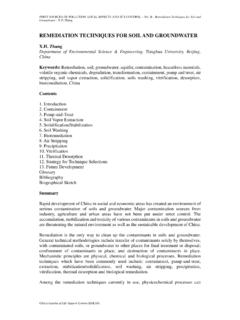Transcription of BENZENE, TOLUENE AND XYLENE BIODEGRADATION BY ...
1 Brazilian Journal of Microbiology (2005) 36:258-261. ISSN 1517-8382. benzene , TOLUENE AND XYLENE BIODEGRADATION BY. pseudomonas putida CCMI 852. Marcelo Henrique Otenio1; Maria Teresa Lopes da Silva2; Maria Luiza Oliveira Marques2; Jos Carlos Roseiro2;. Ederio Dino Bidoia1*. 1. Instituto de Bioci ncias, Departamento de Bioqu mica e Microbiologia, Universidade Estadual Paulista, Rio Claro, SP, Brasil. 2. Laborat rio de Microbiologia Industrial, Instituto Nacional de Engenharia e Tecnologia Industrial, Estrada do Pa o do Lumiar, Lisboa, Portugal. Submitted: May 11, 2004; Returned to authors for corrections: April 25, 2005; Approved: September 20, 2005.
2 ABSTRACT. A minimal liquid medium containing benzene (B), TOLUENE (T) and XYLENE (X) and mixtures thereof, was used to evaluate degradation activity of pseudomonas putida CCMI 852 containing a TOL plasmid. Experiments were developed with B, T and X (100 mg L-1), with mixtures of BT, BX, and TX (50 + 50 mg L-1 each) and BTX. ( + + mg L-1 each), added to 500 mL of medium. After 18 to 24 hours, the inoculum was added and solvent disappearance was determined after 24 to 25 hours by GC. Results showed that P. putida CCMI 852. was able to metabolize T and X, but B was not metabolized. In a BTX mixture, B was not metabolized and T and X degradation rate decreased 50%.
3 Key words: pseudomonas putida , BIODEGRADATION , BTX, plasmid TOL. INTRODUCTION consortium growing on gasoline, suggesting co-oxidative or syntrophism processes (16). benzene , TOLUENE and XYLENE isomers (BTX) are the major When bacterial cells were exposed to mixtures of aromatics components of gasoline (5). Because of their low water solubility present at equal concentrations, degradation patterns were and their acute toxicity and genotoxicity (6), BTX components modified substantially from those of individual BTEX. are classified as priority pollutants by the Environmental compounds, disappearing according to the sequence Protection Agency (9).
4 Due to the sequences of accidental ethylbenzene, TOLUENE , benzene and XYLENE (7). gasoline spills and leakage from service station tanks, they are Bacteria able to degrade TOLUENE and XYLENE are also able to prime sources of aquifer contamination (3). degrade benzene . When the two compounds were present BTX degradation by microorganisms possesses several together, they exerted an antagonist effect, they were advantages over traditional methods (2,4,13,14). Enriched degraded at a lower rate than TOLUENE and XYLENE alone (1). cultures obtained from soil exposed to BTX mineralized benzene pseudomonas can adapt to diverse substrates and possess and TOLUENE and co-metabolized XYLENE isomers, producing several catabolic pathways capable of acting on recalcitrant polymeric residues (17).
5 Substances. Some studies with pseudomonas putida identified The screening of 297 bacterial isolates from soil revealed metabolic pathways dedicated to gasoline components, like their ability to degrade hydrocarbons constituent of gasoline, benzene , TOLUENE and XYLENE . Also, they show a schematic and 75% of the isolates grew on TOLUENE vapor as sole carbon diagram of the metabolic pathways constructed in P. putida for and energy source (16). benzene and naphthalene were less degradation of the BTX mixture (12,15). The TOL pathway in frequently degraded than substituted aromatics. These non- BTX mixture BIODEGRADATION does not utilize benzene as a substituted hydrocarbons were degraded by a microbial substrate (12).
6 P. putida PaW15 initiates TOLUENE degradation at *Corresponding Author. Mailing address: Instituto de Bioci ncias, Departamento de Bioqu mica e Microbiologia UNESP. 13506-900, Rio Claro, SP, Brasil. Tel.: (+5519) 3526-4191, Fax: (+5519) 3526-4176. E-mail: 258. Degradation of BTX by P. putida the methyl group, eventually forming benzoate, which is (Supelco, USA) using Helium as carrier, at a flow rate of 10 mL. degraded by the meta cleavage route. XYLENE also undergoes min-1. The column temperature was programmed at an initial the same oxidative reaction, giving rise to the methyl-benzyl- temperature of 40 C for 1 min, then increased at 20 C min-1 to alcohol formation.
7 However, TOD pathway utilizes benzene as 160 C and held there for 8 min. Injector and detector temperatures substrate (15). were 250 C and 260 C, respectively. Splitless injection was used. The aim of the present work was to characterize and quantify For the extraction of the solvents, SPME fiberTM coated with a the activity of pseudomonas putida CCMI 852, on benzene , 100 mm coated Polydimethylsiloxane layer was used immersed TOLUENE , XYLENE and mixtures thereof. in the sample. The exposure time was 5 minutes with vigorous stirring at room temperature. The SPME fiberTM was then injected MATERIALS AND METHODS into the chromatograph (9).
8 Each sample was injected twice. Microorganism and inoculum preparation RESULTS. pseudomonas putida CCMI 852 from the Culture Collection of Industrial Microorganisms was isolated from an effluent Different degradation rates were found in shake flasks treatment plant (Frielas, Portugal). The strain was identified containing B, T, and X. TOLUENE was degraded at a two-fold rate using the Biolog system for microbial identification (Biolog Inc., than XYLENE . benzene concentration remained unchanged. When USA) and maintained as freeze-dried cultures. Slants of TSA degrading two component mixtures, TOLUENE was utilized at a were obtained by growth at 30 C for twenty-four hours.
9 Cells rate by 73% lower in the presence of benzene and at a rate by were removed from the slants and transferred into 1000 mL screw 37% lower in the presence of XYLENE . The utilization of XYLENE capped cultivation flasks containing 500 mL of mineral medium also decreased by 53% in the presence of benzene and by 15%. of the following composition (per liter): KH2PO4 g; Na2 HPO4 in the presence of TOLUENE . benzene concentration remained g; (NH4)2 SO4 g; and 2 mL of a micro-nutrient elements unchanged. The three components mixture also revealed a solution (18). benzene , TOLUENE and XYLENE were used as carbon decreased specific degradation rate of TOLUENE (57%) and XYLENE sources.
10 (49%). In the presence of individual substrates, the induction time was 19 hours. In the two and three components mixtures, BIODEGRADATION Tests the induction times varied in a non-uniform pattern, ranging A bottom side-arm with a silicon membrane and aluminum between and 26 hours (Table 1). cap was used to remove samples from the flasks, using a sterile syringe and needle. benzene ( Merck, Germany), TOLUENE ( Merck, Germany) and XYLENE (mixtures of isomers, Merck, Germany), were added to 500 mL of minimal medium (100 Table 1. Induction time and degradation rates for benzene (B), mg L-1 in single substrate media, 50 mg L-1 of each solvent in TOLUENE (T) and XYLENE (X), and mixtures thereof by P.)













